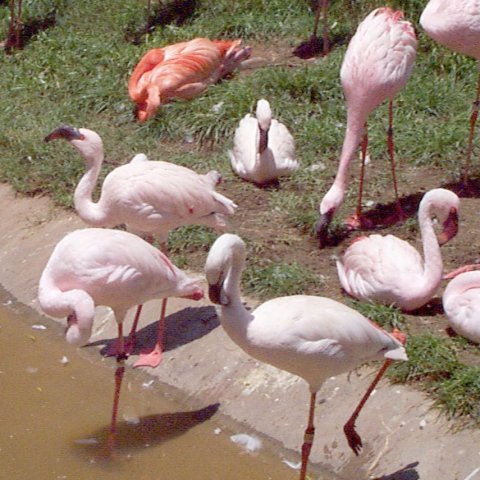
Even though the Lesser Flamingos are the most abundant flamingos, many flamingos in general have been dying. Veterinary pathologists in Kenya have identified heavy metals as the leading cause of massive deaths of flamingos in two Rift Valley Lakes of Kenya, and warned that the scenic pink birds of Lakes Nakuru and Bogoria remain threatened unless the lakes are cleared of pollutants. "The presence of heavy metals in the birds tissue is alarming," cautioned Dr. Gideon Motelin, a veterinary pathologist at Egerton University who last month conducted a three-day fact finding mission in the two lakes. Motelin is leading Kenyan researcher on flamingos.
The Kenya Wildlife Service (KWS) acknowledges that Lake Bogoria is the "worst affected" but gave no data on the number of birds that have died. Journalists have counted hundreds of birds' carcasses littering the shores of both lakes. But the wildlife agency played down pollution as the cause of deaths. "If it's a question of pollution, why is it affecting both Lakes. We could understand if it was only in Nakuru but Bogoria is far away from industries," said Daniel Njaga, a communications officer at KWS. t is known that lesser flamingoes in the Rift valley (East Africa) congregate at certain lakes in flocks exceeding a million individuals, while at other times these same lakes contain only small numbers. The causal factors behind these dramatic changes in distribution or distribution patterns across the range over time have been poorly understood. The distribution of the lesser flamingo population along the lakes of the Rift valley was measured by a series of aerial censuses carried out over a two and a half year period from 1974 to 1976.
Data were collected on the on the standing crop densities of the blue green algae Spirulina and benthic diatoms (the primary food resources of lesser flamingoes in East Africa) and on basic lake morphometry and water chemistry. High flamingo densities at a site correlated with availability of high standing crop densities of Spirulina. Spirulina blooms are not widely available over space or time, and their density fluctuates very rapidly and unpredictably. Benthic diatoms are far more widely available and predictable but are much lower in quality, productivity and carrying capacity. Theoretical energy budget models explain the high flamingo flock densities associated with the presence of high density blooms of Spirulina. The productivity and carrying capacity of benthic diatoms is one to two orders of magnitude less than Spirulina and explains the much lower flock densities and more dispersed distribution pattern at times when the population is dependent on benthic diatoms as its primary food resource.
Cruickshank, Allan. Cruickshank's Photographs of Birds of America. New York: Dover Publications, Inc. 1977. p. 35.
Peterson, Roger. A Field Guide to the Birds. Boston: Houghton-Mifflin Company. 1934. p.30.